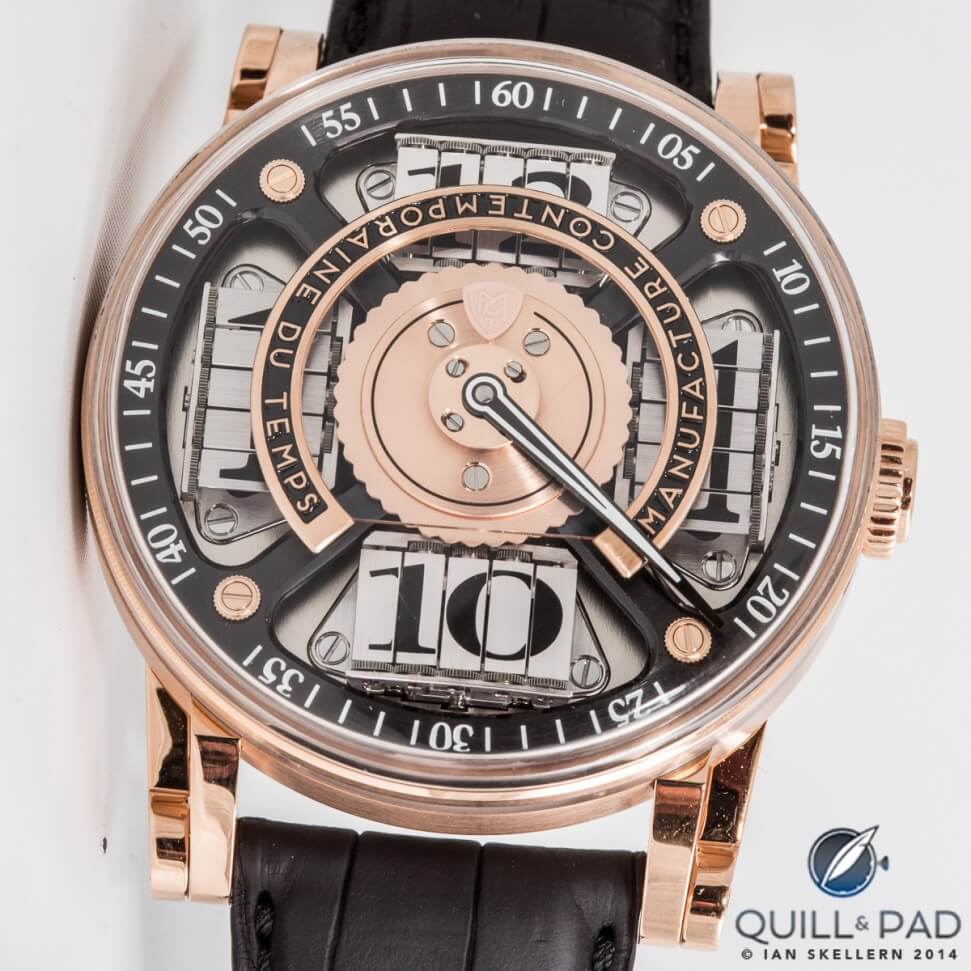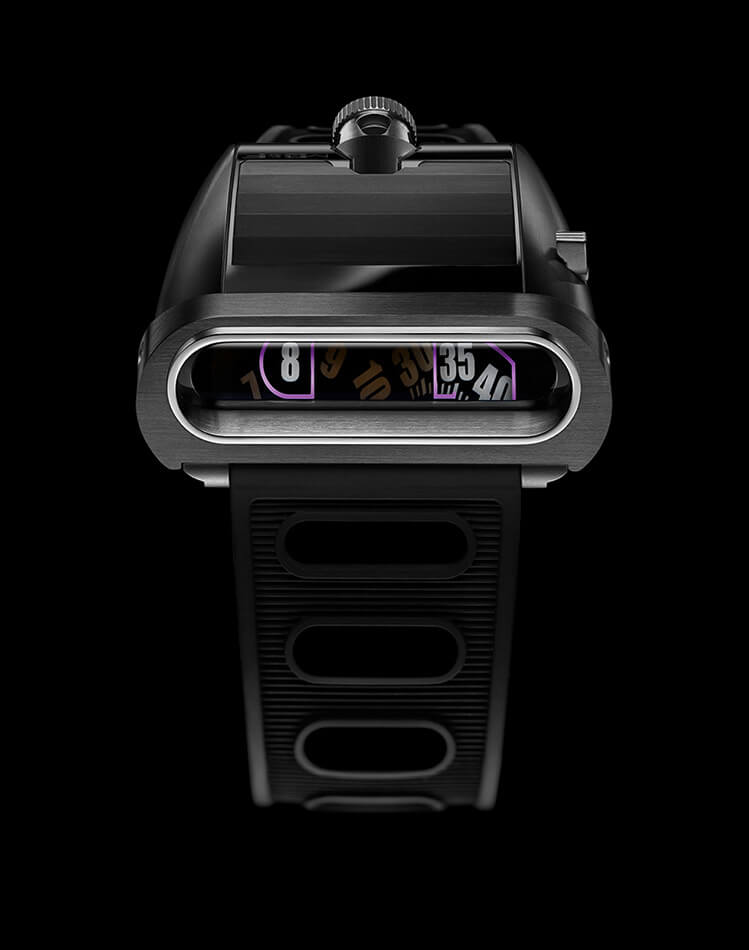The Jump Hour: A Love Story – Reprise
JUMP! (JUMP!) You might as well jump!
Those are the immortal words sung by Van Halen front man David Lee Roth in the band’s 1983 hit single “Jump” and they could not be more appropriate.
Literally.
For health reasons if not for pure fun, jumping is a fantastic activity and even better when it is placed inside of a timepiece.
“What?” you say! No lengthy introduction of some (very loosely) aligned topic before going into the dirty details of some amazing piece of wrist technology?
Nope, because this isn’t just some lengthy soliloquy for the latest and greatest, but actually my nomination for the most fun and varied non-complication complication ever put in a watch: the jump hour.
The jump hour has a long history, beginning in mid-nineteenth century France and stretching all the way to today with numerous brands putting their own spin on the “complication.”
Now, first things first, it can’t technically be called a complication since the accepted definition of complication is a mechanism that provides information other than the time. Therefore, retrograde hands, jump hours, constant force mechanisms, and the all-mighty tourbillon are all (technically) excluded.
That being said, anyone who gives a hoot will say in the same breath that there are many complications that don’t fit that definition, because to many a complication is something that goes above and beyond showing the time simply by the traditional, never-ceasing hands.
And I couldn’t agree more.
Being a person who prototypes things for a living, I know from many projects that have nothing to do with watchmaking that trying to do a task that has been done a million times by everybody and their uncle is still an undertaking.
Now, deviating from that plan and coming up with a new way to do the same thing is, many times, a herculean task all itself.
Because We Can (BWC)
So why on earth does an object need to do something other than what is required of it to be complicated? Why is making a car run on banana peels not considered a complicated deviation from the norm?
Oh that’s right, it is considered a complicated deviation from the norm. But only in watchmaking do you have a somewhat rigid definition for the word “complicated,” which then leaves an entire class of mechanisms out in the cold.
Maybe we need a new class of complication. Perhaps a “BWC” complication: “Because We Can.”
I think that many have tried very complicated things simply because they could, and we are all the better for it. Just take a look at almost every major improvement to the portable timepiece in the last 400 years.
Maybe only 10 percent of them might be considered complications, the rest are just improving upon the same idea so that now we have amazingly technical and accurate timepieces that also still just tell time.
So in an effort to be fair, I will say that my favorite BWC complication is the jump hour mechanism. It is an elegant and “simple” way to show the time digitally, meaning with digits or numerals instead of analog with hands or pointers.
If you have been following my writing over the past year, you might have noticed that I have written about six jump hour watches, and three of those have been in the last month.
My last article featured the HYT H2, which also has a jumping hand function (very clever in itself) so it is hard for me to get away from the topic of “jumping” anything. (See When Opposites Collide: Microfluidics Of The HYT H1 And H2.)
So darn fun
And that is because they are so darn fun and rather complicated in their construction. I should know, having poured over the mechanism photos and videos of almost every jump hour watch I come across, and since I began writing about watches a year and a half ago, I have tried to explain in writing nearly a dozen different mechanisms that create my favorite function.
As alike as they are in principle, they are very different in execution. To me, this makes for a horological party while I absorb the new layouts and clever ways to make something simply jump from one number to the next.
Take the Romain Jerome Spacecraft for example, it uses two snail cams, two lever arms, and a rack and pinion to create controlled movement of an hour arm that simply pushes a carriage slider along a rail, and then it goes back to the beginning. Granted, that while that second snail cam and lever arm are for the retrograde motion, it still is a unique take on a very old complication. (See A Brief History Of Transportation Ending With The Romain Jerome Spacecraft.)
The most complicated jump hour (and jump minute) watch out there is probably the 4N watch by original Hautlence designer François Quentin. This watch has a very complicated system of three turntables that counts the minutes and hours digitally, and all jumping in a very beautiful dance on the dial.
It looks straightforward until you think for a minute about how it needs to provide that much power and control it that precisely to move up to three turntables smoothly, all day long. It is a masterpiece of cleverness.

Van Cleef & Arpels Heure d’ici & Heure d’ailleurs (“time here and time elsewhere”) on the wrist of Denis Giguet
A most enjoyable mechanism
One of the most enjoyable mechanisms of the past year came in the shape of the Van Cleef & Arpels Heure d’ici & Heure d’ailleurs. This has a dual time zone and a dual jump hour mechanism, which is incredible to look at. Based on a single snail cam and lever arm that activates both jump hour mechanisms, the lever arm must have a dozen critical surfaces and features, making for a very important component that controls the entire show.
The lever arm catches are actually tiny springs with hooks on the tip. As the lever arm charges over the hour, the spring hooks slide past their intended catches into a position where they can activate both of the jump hour wheels on its return trip. At the top of the hour the lever arm slips off the snail cam and a tightly controlled ballet occurs in an instant. I love it.
And then you have the MCT Sequential One and Two, which slowly change the hour displays through the hour, but have a rotating indicator ring that jumps at the top of the hour moving to the next hour to be indicated. (See Evolution, Chocolate Cake, And The MCT Sequential Two. What?)
The Ludovic Ballouard Upside Down watch is particularly fun as it has twelve “Geneva” wheels that are activated two at a time by a rotating ring that is made to jump by a sprung lever arm riding on a – you guessed it – snail cam. (See When Confusion Paves The Way To Awe: The Ludovic Ballouard Upside Down.)
If anything, you might even be able to call the jump hour mechanism the snail cam jump mechanism as it is a very efficient way to store up potential energy to create a quick or jumping motion in the movement.
Basically, it’s all about slowly lifting an arm with some sort of catch or hook on it over the course of the hour.
There is a spring pressing down on it the entire time it rides up the slowly increasing spiral of the snail cam until it reaches the end of the spiral and “slams” back down to the lowest point. As it whooshes back to its resting position, that hook or catch usually triggers a change or grabs a wheel and moves it to the next position.
This is the most basic version of the jump hour mechanism: a lever that activates a wheel to change as it returns to its lowest point after riding up a snail cam. But some jump hours take advantage of a star wheel, which is basically a gear wheel that has points instead of gear teeth and is driven by a single-tooth gear.

A preview of the upcoming Speake-Marin Jumping Hours, a unique piece still being finalized. It features central minutes with four small hour hands that jump sequentially every 15 minutes using a specially developed system of star wheels
These can actually be the mechanically simplest jump hour mechanisms. If done in a specific way, they won’t actually jump, but simply become a digital hour display that slowly changes at the top of the hour, kind of like a (non-instantaneous) date wheel.
To achieve that jump, the star wheel would have to be, according to one layout, indirectly attached to the hour wheel via an intermediate ratchet wheel. The star wheel would have to snap into place to activate a quick tug on the ratchet wheel, which would in turn activate the hour wheel to snap into position.
I am currently experimenting with one such design for myself in the hopes that I can incorporate it into a watch in the future, simply because I can. And I have been inspired by many great pieces out there.
De Bethune has released some great examples of jump hours (see The Nine Muses And The De Bethune DB28 Digitale) as well as A. Lange & Söhne (the holy grail: the Zeitwerk), Audemars Piguet, Cartier, Jaquet Droz, Harry Winston, Bulgari, and even little guys like Christopher Ward. Not to mention numerous others with increasingly complicated designs.
I would love to break down every mechanism out there, and there might even be a reader or two who would love me to do so, but I urge you to keep your eyes open and find examples that you love. Maybe you can even go back and read over some pieces we have written about on Quill & Pad; there are some real doozies in there.
I will continue to research and continue to love the jump hour. I want to come up with a variety of ways to do the same thing because it is always exciting to think of a better way to make a function a reality. I have my fingers crossed that my plans come to fruition, but if not I have many more ideas to try and designs to be inspired from.
The jump hour is one of the most fun BWC complications out there, and it comes in a variety of packages for every taste.
If I had to pick just one to wear every day, it would be a real battle for sure. The Bell & Ross WW1 Heure Sautante Pink Gold is a strong contender, as is the De Bethune DB28 Digitale. But I couldn’t forget about the A. Lange & Söhne Zeitwerk, which has a stranglehold on my heart.
Alas, maybe I will just wear them all!
* This article was first published on November 23, 2014 at The Jump Hour: A Love Story.
You might also enjoy:
Blancpain Villeret Tourbillon Volant Heure Sautante Minute Rétrograde: A Triple First
The 8 Most Accurate Moon Phase Wristwatches Today
Leave a Reply
Want to join the discussion?Feel free to contribute!











Thank you for reposting this article, as I, like the author, am fascinated with jump hour complications. (We apparently share the same fascination with retrogrades as well, as it turns out.) As I turn my attention to starting a sub-collection around jump hour watches, could you please recommend any books for reference? If there is no definitive book out there, perhaps it is time for someone on the Quill & Pad staff to work towards one 🙂 Thank you in advance!
Thanks for the idea – I have had one rolling around my head forever on this topic, but have had no time to devote to it!